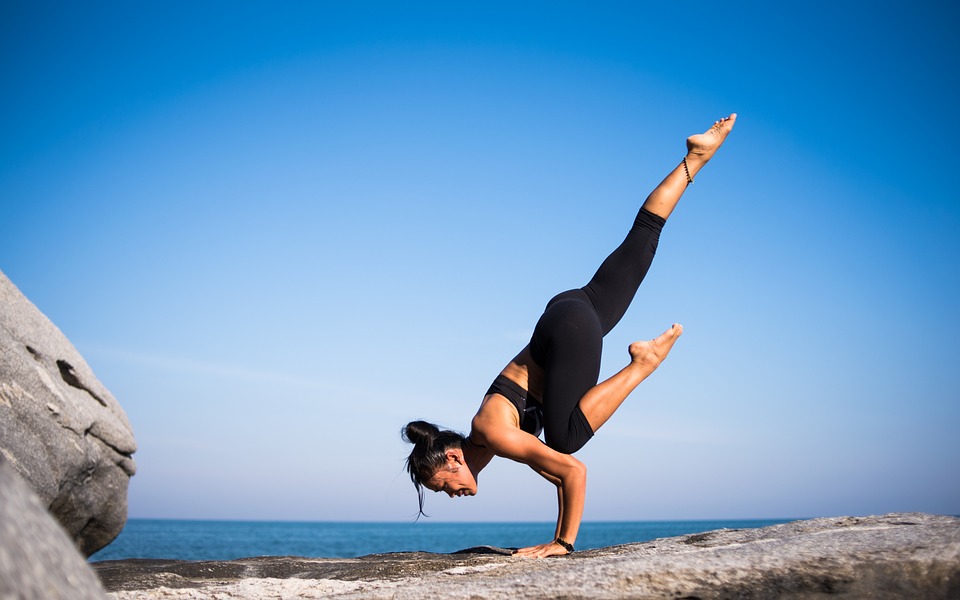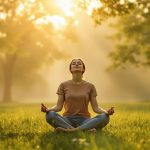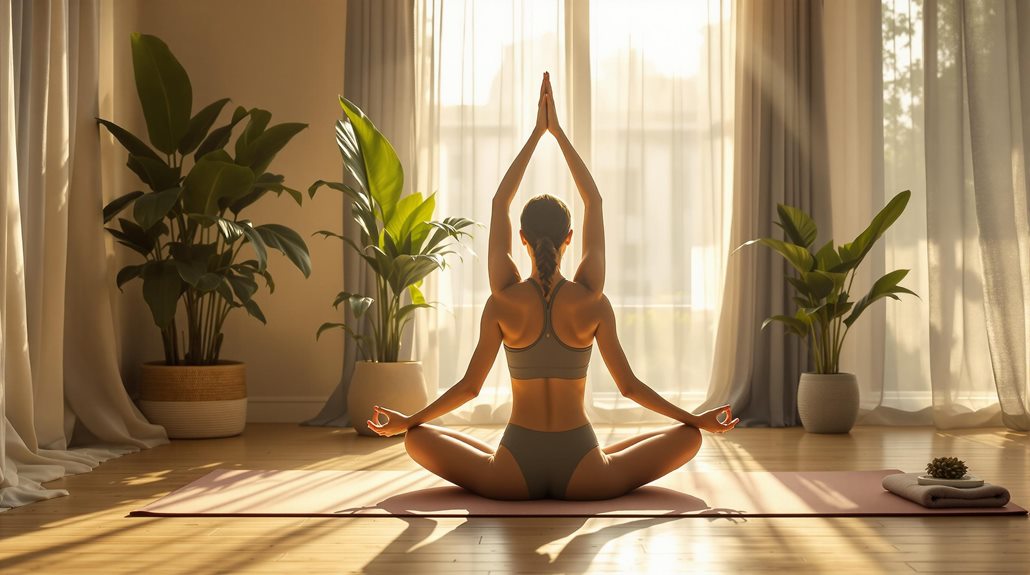
Practicing yoga can profoundly calm your mind and transform your mental well-being. By engaging the parasympathetic nervous system, yoga promotes deep relaxation and reduces stress. It lowers anxiety through mindful breathing and increases the production of mood-boosting hormones like serotonin and endorphins. The practice enhances mental clarity, sharpens your focus, and creates structural changes in the brain that improve memory and learning. Yoga also encourages present-moment awareness, allowing you to regulate your emotions more effectively. As you explore further, you’ll discover how the various styles and poses of yoga can deepen your sense of calm and serenity.
Understanding Yoga’s Mental Benefits
Practicing yoga regularly can transform your mental well-being by sharpening your focus and clarity. Embracing yoga doesn’t just stretch your body—it calms the mind and enhances mental clarity. You might be wondering how a few postures and breathing techniques can make such a difference. The answer lies in how yoga engages your parasympathetic nervous system, effectively promoting relaxation and reducing stress. As you engage in yoga, you’ll find distractions from anxiety become less dominant, and your mood improves. Incorporating elements like meditation and mindful breathing into your yoga routine can further strengthen emotional resilience. During yoga practice, the focus on mindful breathing and relaxation techniques activates parts of your brain associated with emotional regulation. This transformation is significant for your mental health; you’ll notice an increase in the production of GABA, a neurotransmitter that plays a crucial role in reducing anxiety and enhancing your mood.
Moreover, studies indicate that yoga leads to structural changes in your brain, such as increasing hippocampal volume. This alteration is particularly beneficial for your memory and learning abilities. In essence, the consistent practice of yoga offers you one of the most effective methods to reduce stress and build resilience against mental health challenges, promoting a lasting sense of well-being.
How Yoga Reduces Stress
Unlock the power of yoga to melt away stress and invite tranquility into your life. Yoga reduces stress through its profound impact on your body’s key systems. When you engage in yoga, you activate the parasympathetic nervous system, a crucial player in promoting relaxation and counteracting the stress response. This shift helps manage cortisol levels, the hormone primarily responsible for stress. Lowering cortisol levels leads to a calmer mind and a more balanced state of being. For even greater stress relief benefits, you can explore other practices that involve deep breathing techniques or incorporate mindfulness into your daily routine. Incorporating breathing techniques, like deep belly breathing, into your practice is essential. These techniques are powerful tools in reducing anxiety and enhancing mental clarity. As you focus on your breath, you’ll discover a decrease in anxiety levels and an improved ability to concentrate, sharpening your mental clarity.
Regular yoga practice encourages you to embrace the present moment, steering you away from stressful, ruminative thoughts. Studies even show that yoga boosts the production of GABA, a neurotransmitter linked to improved mood and reduced anxiety. Embracing yoga’s mindful movements and intentional breathing doesn’t just reduce anxiety; it cultivates a holistic sense of wellness, allowing you to calm your mind and navigate life’s challenges with poise.
Mindfulness Through Yoga
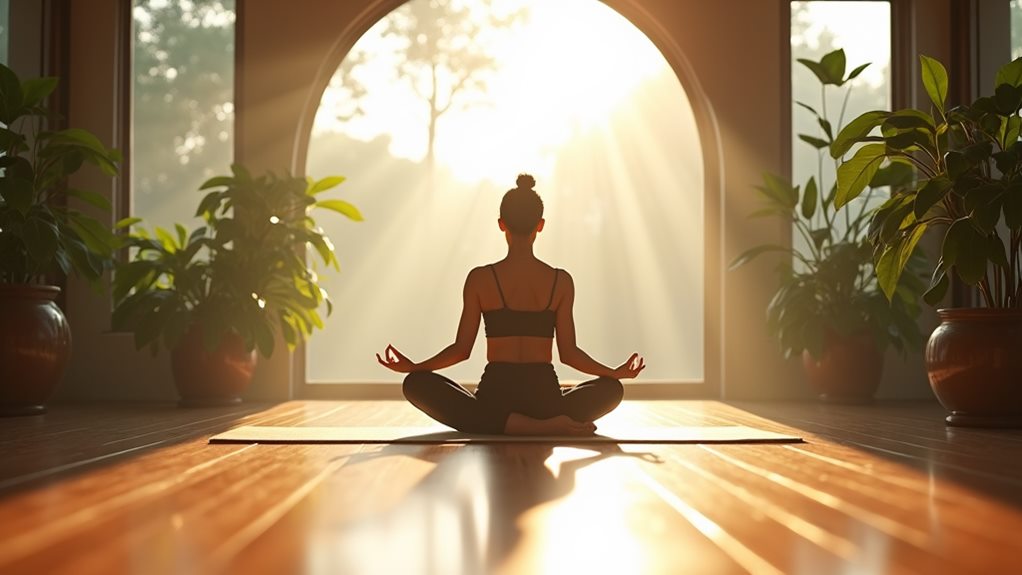
Why is mindfulness through yoga such a transformative practice? It enhances your present-moment awareness, allowing you to notice thoughts and emotions without reacting impulsively. This fosters emotional regulation, helping you navigate stress and maintain calm in challenging situations. With regular yoga practice, you activate the parasympathetic nervous system, which is responsible for promoting relaxation and reducing stress hormones. Engaging in physical activity like yoga also releases feel-good hormones, similar to those released during exercise, further improving mood and resilience. This physiological shift can lead to a noticeably calmer mind and increased mental wellbeing.
Incorporating breathing techniques like Ujjayi Breath during your sessions counteracts shallow breathing patterns often linked to anxiety. You’ll find that focusing on your breath deepens your mental clarity, fostering a sense of relaxation. Moreover, by modulating the default mode network (DMN) in your brain, consistent yoga practice can reduce rumination and mind-wandering. This improvement in focus and cognitive function is another reason why engaging in mindfulness through yoga is truly transformative.
Additionally, yoga not only bolsters emotional resilience but also boosts the production of feel-good hormones like serotonin and endorphins. By embracing mindfulness in your yoga practice, you cultivate a state of calm, effectively enhancing your overall mental wellbeing and resilience.
Styles of Yoga for Relaxation
Exploring different styles of yoga can significantly enhance your relaxation journey. Each style uniquely promotes relaxation and offers calming effects on your mind and body. Here’s a look at five styles that can transform your practice:
- Restorative Yoga: With gentle poses held for several minutes, this practice uses props for support, leading you to a state of deep relaxation. It’s perfect for stress reduction and bringing a sense of tranquility.
- Hatha Yoga: Known for its slow-paced approach, Hatha Yoga combines postures with breathing exercises. This is ideal for beginners who’ve just begun their journey in relaxation and mindfulness, offering a solid foundation.
- Yin Yoga: By holding poses for 3-5 minutes, Yin Yoga targets deeper connective tissues. This style not only improves flexibility but also calms your mind through extended stillness and introspection.
- Yoga Nidra: Often called yogic sleep, Yoga Nidra guides you into profound rest, equivalent to four hours of deep sleep in just one hour. It’s a powerful technique for stress relief and mental rejuvenation.
Each style offers unique benefits for calming effects and mental clarity. Embrace these practices to enhance your relaxation journey.
Essential Yoga Poses for Calmness
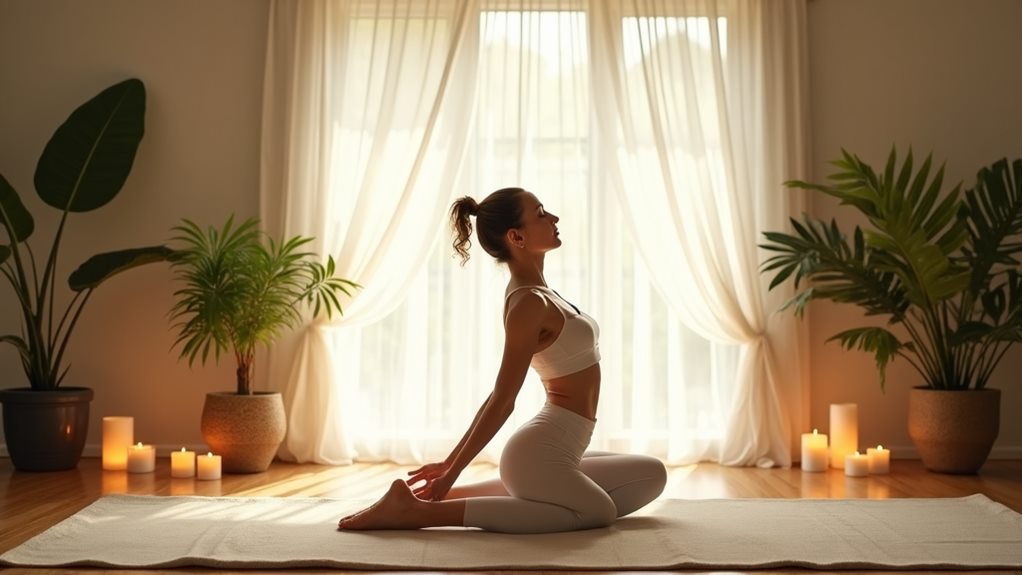
Ready to elevate your relaxation journey even further? Dive into yoga poses that transform stress into serenity. Begin with the Child Pose (Balasana). This restorative posture grounds you, effectively calming the nervous system. It’s like hitting a reset button on stress, promoting relaxation. Transition into the Supported Bridge Pose, where opening your chest not only reduces body stress but also boosts your energy levels. Emotional release follows, paving the way for profound calmness.
Next, find tranquility in the Legs Up The Wall Pose (Viparita Karani). Imagine ending a long day with fatigue melting away as your nervous system unwinds. This pose is perfect for unwinding and promoting relaxation. Continue with Supported Supta Baddha Konasana, a serene posture that supports your back while encouraging deep breathing. It’s your ticket to mental tranquility, as it nurtures the flow of calmness within you.
Breathing Techniques in Yoga
Picture your breath as the gentle conductor of a symphony, orchestrating calmness and balance within you. Breathing techniques, or pranayama, are key to achieving a calm mind in yoga. By regulating your autonomic nervous system, these techniques adeptly reduce stress hormone production. Here’s how you can use them:
- Ujjayi Breath: This involves slow, deep inhalations and exhalations through your nose. It helps relax your mind and is often used during Ashtanga yoga. The focus required can steer your thoughts toward serenity, promoting mental clarity.
- Alternate Nostril Breathing (Nadi Shodhana): You alternate breathing through each nostril, balancing your body’s energy and reducing anxiety. This technique fosters a deep sense of calm, aligning your nervous system toward tranquility.
- Deep Belly Breathing: Engage in this basic yet profound technique to activate your parasympathetic nervous system. By doing so, you’ll lower your heart rate and enhance relaxation, cultivating emotional resilience.
- Improved Mental Clarity: With regular practice, these breathing techniques can fortify your ability to cope with stress and clarify your mind, making life’s challenges seem more manageable.
Incorporate these practices into your yoga sessions for a more peaceful, centered you.
Integrating Meditation With Yoga
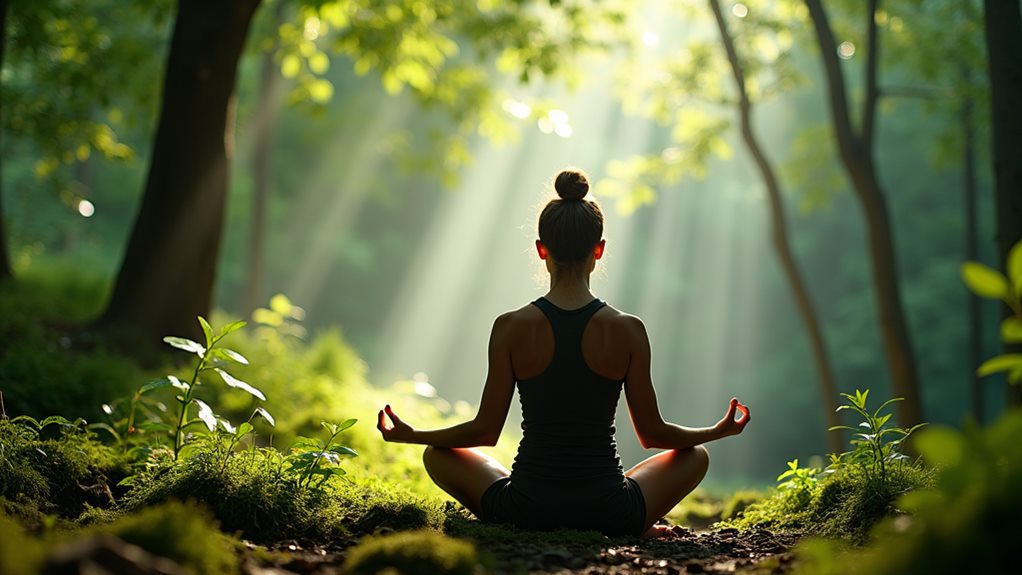
Building on the calming foundation of breathing techniques, integrating meditation with yoga elevates your practice to a new level of mindfulness and tranquility. When you combine yoga and meditation, you’re not just stretching and strengthening your body. You’re shifting into a mental state that significantly reduces stress and anxiety levels by fostering present-moment awareness. Regular practice yoga doesn’t stop at physical benefits; it deepens emotional resilience, thanks to increased gray matter in brain regions linked to emotional regulation and memory.
By practicing yoga, accompanied by meditation, you enhance the activation of your parasympathetic nervous system, achieving deep relaxation and profound calm. You’ll find that these sessions not only improve mental clarity but also help in making better decisions. The synchronized breath and body work encourage deeper breathing patterns, which are key to better cognitive function.
Embrace the synergy yoga and meditation offer. With each pose, each breath, you’re scripting new chapters of calm, mental clarity, and resilience. Don’t just practice yoga on the mat—make it a gateway to meditative tranquility. Feel each breath, each movement as a step toward a balanced, stress-free life. Your mind and body deserve it.
Yoga for Better Sleep
Yoga can transform your nights. By integrating the practice of yoga into your daily routine, you can significantly boost your chances of achieving better sleep. The calming nature of yoga helps create an environment that reduces stress, ideal for restful nights. Here’s how it works:
- Lower Cortisol Levels: Regular yoga practice can decrease cortisol, the stress hormone, which often keeps you tossing and turning. This reduction paves the way for relaxation and peaceful slumber.
- Ease Anxiety: Racing thoughts and anxiety are major sleep disruptors. Incorporating yoga into your bedtime routine can calm your mind, making it easier to fall and stay asleep.
- Bedtime Routine: Establishing a calming pre-sleep ritual with specific styles like Yin yoga or restorative poses encourages your body to relax. These practices signal it’s time for bed, helping set a consistent sleep schedule over time.
- Breathing Exercises: Deep breathing techniques during yoga sessions not only enhance respiratory health but also induce a state of relaxation. This aids in falling asleep faster and contributes to overall mental health.
Start incorporating yoga today and experience the transformative power of better sleep!
Practicing Yoga at Home
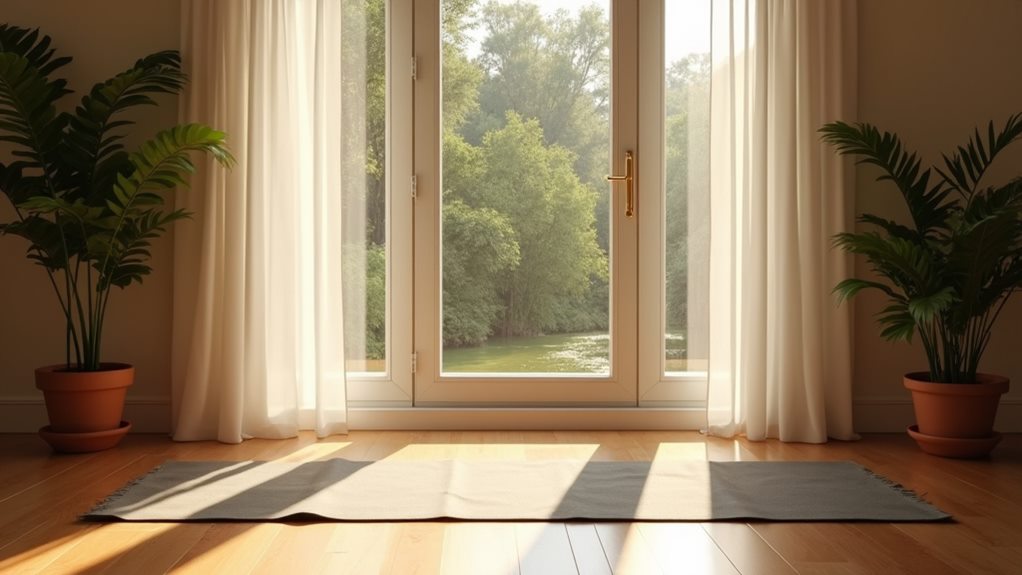
Practicing yoga at home offers a unique and personalized experience that can dramatically enhance your mental well-being. By choosing styles and poses that fit your needs and comfort levels, you gain control over your practice, making it adaptable for all ages and fitness levels. A home practice not only boosts flexibility but also allows for the integration of stress management techniques into your daily routine.
When practicing yoga at home, you can create a clutter-free and comfortable space that enhances focus and relaxation. This environment contributes to a calmer mind, providing a sanctuary where you can unwind and clear your thoughts. Regular home practice, even if it’s just a few minutes each day, significantly impacts mental health by reducing stress and anxiety levels.
Don’t underestimate the power of incorporating breathing techniques and mindfulness into your sessions. These practices are crucial for maintaining present-moment awareness and achieving a serene mind. Proper equipment, like yoga mats and blocks, supports your home practice by offering stability and reducing injury risks. When you commit to a consistent yoga routine at home, you’re not just investing in physical health, but also unlocking the door to mental clarity and emotional balance.
Safe Yoga Practices
As you embrace yoga at home and enjoy its calming benefits, ensuring safety in your practice becomes a top priority. Adopting safe practices not only maximizes the health benefits but also enhances your mental well-being, helping to reduce stress effectively. Here’s how you can prioritize safety during your yoga sessions:
- Consult a Professional: Before diving into yoga, especially if you’ve had chronic health conditions or injuries, reach out to a healthcare expert. They can tailor a safe practice that aligns with your unique needs, ensuring your physical postures are both effective and secure.
- Warm Up Thoroughly: Preparing your body with a proper warm-up decreases the risk of injury. This step is crucial in maintaining a consistent, injury-free routine while reducing stress through mindful movement.
- Listen to Your Body: Never ignore pain. If a pose feels uncomfortable or painful, ease out immediately. Modify poses to suit your body’s comfort level to gain maximum health benefits.
- Create a Safe Space: Establish a clutter-free environment and use proper equipment like yoga mats and blocks. This supportive setting aids in stabilizing your poses, allowing for a safe and focused yoga session aimed at mental and physical relaxation.
Setting Yoga Goals
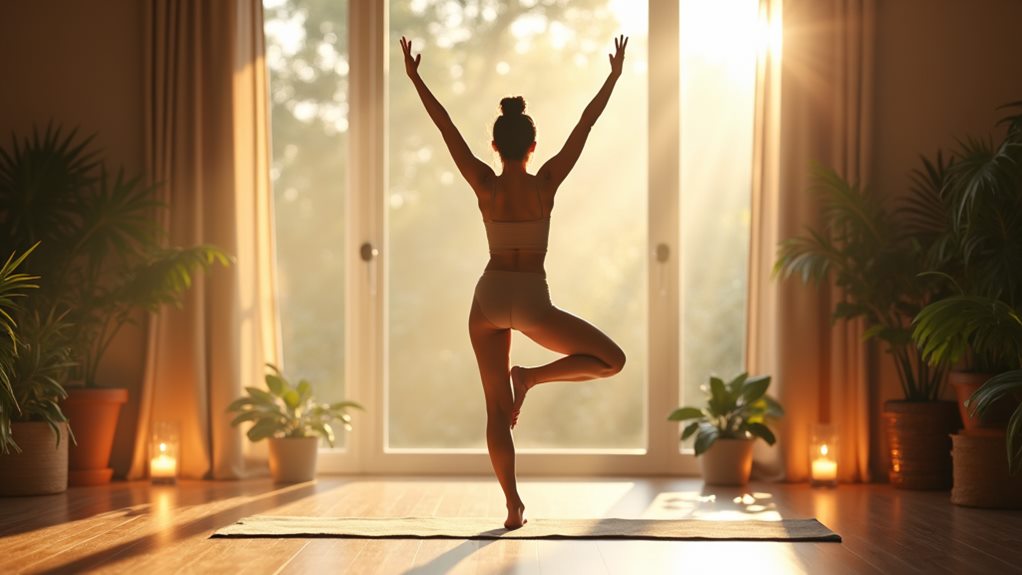
Imagine a roadmap guiding you through your yoga journey, where setting specific goals serves as your compass. These yoga goals, whether they focus on improving flexibility or aiming to reduce stress, provide you with direction and motivation. They aren’t just about physical poses—they’re about fostering mental well-being and achieving a state of balance. By integrating mindfulness into your goals, you can practice being present, which strengthens your mind-body connection and enhances emotional regulation.
Set your intentions clearly. Maybe it’s the goal of practicing mindfulness to reduce anxiety or creating a consistent practice routine of using the mat 3-4 times a week to reap yoga’s calming effects. Each session you commit to brings you closer to a calmer mind. Consistent practice doesn’t just improve your skills—it amplifies the calming effects on your mental state. Regularly assessing your progress encourages self-reflection, nurturing resilience, and grounding you in the present moment.
Establishing yoga goals fuels your journey with purpose. They’re not just milestones; they’re powerful tools for promoting tranquility and mental clarity. So, set your course, stick to the path, and let these goals transform your practice and your life.
Choosing the Right Yoga Tools
When embarking on your yoga journey, selecting the right tools can be a game-changer. The right equipment not only enhances your practice but also cultivates a deeper sense of mindfulness and relaxation. Let’s dive into the essentials:
- Yoga Mat: A high-quality yoga mat is your foundation. It offers superior grip and comfort, preventing slips and allowing you to focus fully on your mind-body connection. Choose a mat that feels right under your feet, one that aligns with your personal practice style—be it vigorous or restorative.
- Yoga Blocks: These are must-haves for support and stability. They help you maintain proper alignment and safely deepen stretches. Whether you’re a beginner or seasoned yogi, blocks can transform your practice, making challenging poses more accessible.
- Bolster: Embrace relaxation with a bolster to support your body in restorative poses. It encourages relaxation and mindfulness, easing tension so you can hold poses longer without strain.
- Straps: Boost your flexibility and alignment using straps. They enable you to explore difficult stretches and find your optimal pose comfortably.
Enhancing your practice further, consider adding essential oils or aromatherapy diffusers to create a calming atmosphere that elevates your yoga experience.
Frequency for Optimal Benefits
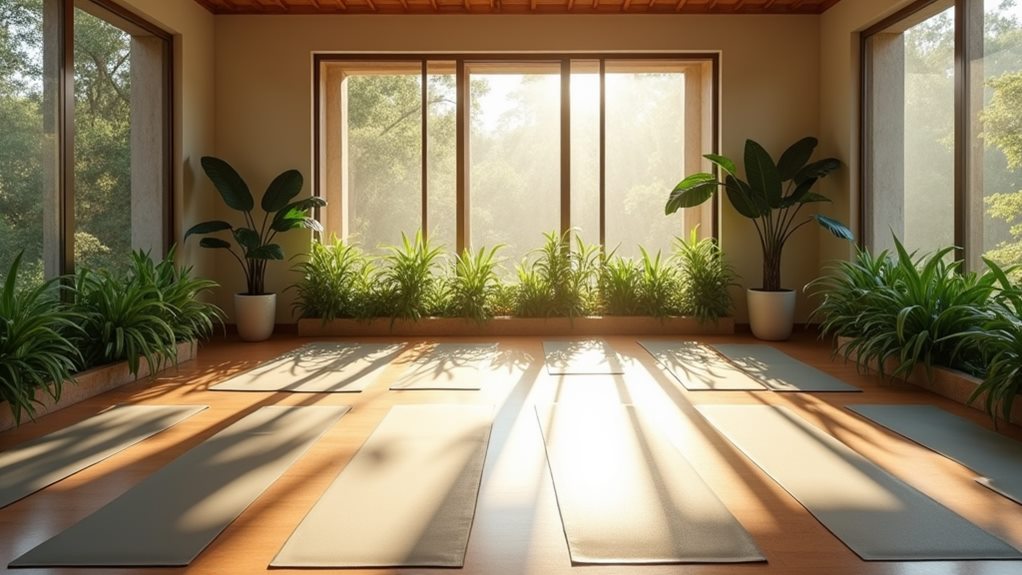
To reap the optimal mental health benefits from yoga, aim to practice consistently, ideally 3-4 times a week. This regular yoga practice isn’t just about physical flexibility; it’s a powerful tool to reduce stress and enhance your mental well-being. Imagine setting aside just 30 minutes per session—these moments can transform your body and mind, fostering greater emotional regulation and resilience.
Your practice can help you navigate anxiety and depression, offering a natural defense against these common struggles. By incorporating both physical poses and breathing techniques, you’re equipping yourself with a holistic approach that optimizes relaxation and clarity. It’s not only about the poses; it’s about creating a calming synergy between your breathing and movements.
Consistency is key. Tailor your yoga frequency to fit your personal needs and goals. Whether you’re seeking tranquility or tackling life’s challenges head-on, this personalized approach culminates in significant mental health benefits. Embrace yoga as a cornerstone of your routine and watch as the stresses of daily life seem more manageable. Remember, the path to a calmer mind is well within your reach with dedicated, regular practice. Don’t just do yoga—live it.
Deepens Relaxation and Focus
The practice of yoga cultivates a profound sense of calm and focus by engaging both the body and mind in a harmonious routine. By stimulating the parasympathetic nervous system, yoga effectively reduces stress, paving the way for a serene mental state. This mind-body connection is reinforced through mindful movement and controlled breathwork, which not only diminish the production of stress hormones but also foster enhanced emotional stability and clarity. Regular engagement in yoga further boosts the release of neurotransmitters like GABA, supporting an uplifted mood and decreased anxiety levels, which are pivotal for sustaining concentration.
Moreover, yoga deeply enhances cognitive functions such as concentration and memory, largely attributed to its core tenet of mindfulness and living in the present moment. This is not merely anecdotal; consistent practice has been shown to precipitate structural brain changes. Increased activation of the prefrontal cortex—an area of the brain crucial for executive functions like decision-making and maintaining focus—demonstrates yoga’s potential in fostering mental acuity. Therefore, the habitual practice of yoga doesn’t only promise temporary respite but creates lasting cognitive benefits.


